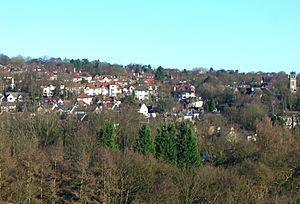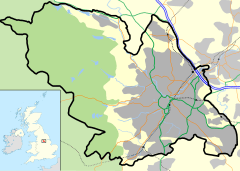Fulwood, Sheffield facts for kids
Quick facts for kids Fulwood |
|
|---|---|
 Fulwood stands on the south facing slopes of the Porter valley, the parish church is far right. |
|
| Population | 18,233 (ward. 2011) |
| Metropolitan borough | |
| Metropolitan county | |
| Region | |
| Country | England |
| Sovereign state | United Kingdom |
| Post town | SHEFFIELD |
| Postcode district | S10 |
| Dialling code | 0114 |
| Police | South Yorkshire |
| Fire | South Yorkshire |
| Ambulance | Yorkshire |
| EU Parliament | Yorkshire and the Humber |
| UK Parliament |
|
Fulwood is a lively residential area and part of the city of Sheffield in England. It is located about 5.5 kilometers (3.4 miles) west-southwest of the city center. Fulwood used to be an old village built along the Porter Brook river. It officially became part of Sheffield in the 1930s.
Fulwood is surrounded by other areas like Lodge Moor to the northwest, Ranmoor to the east, and Crosspool to the northeast. To the west and southwest, you'll find the beautiful open countryside of the Peak District. Some smaller parts of Fulwood include Stumperlowe and Goole Green. In 2011, about 18,233 people lived in Fulwood.
Contents
A Look Back: Fulwood's History
Fulwood was first settled by the Anglo-Saxons, who lived in England a very long time ago. Its name, "Ful Wuda," comes from an old English language. It likely meant "wet, marshy woodland." Some people think it might have meant "dirty wood" or even "folks' wood."
From Ancient Times to Norman Rule
Before the Norman conquest of England in 1066, Fulwood was part of a huge estate owned by an Anglo-Saxon Earl named Waltheof. After Waltheof was executed in 1076, the land was given to a Norman lord, Roger de Busli.
In 1297, a document mentioned Fulwood. It said that people living in "Folewode" could use the land in Rivelin Chase for grazing animals and gathering plants. Rivelin Chase was a large area of forests and moorland. The Lords of the Manor of Sheffield used it for hunting deer and other animals.
Farms, Monks, and Keepers
Records from 1181 show that Fulwood Booth farm was used to raise young cattle for the Lords of Hallamshire. To protect the deer, special keepers were hired. The main keeper was called the "Master of the Game."
Monks from Beauchief Abbey were also given land in Fulwood. They had a farm called a "grange." The monks could graze their cattle and goats there. They also mined for lead in the area near what is now Bole Hill farm. This grange later became the property of Francis Talbot, 5th Earl of Shrewsbury in the 1530s. This happened when monasteries were closed down across England.
Early Buildings and Industries
The Fox family built Fulwood Hall around the 15th century. It was one of the first large houses in the area. Bennett Grange was built nearby in 1580. It has been added to over the years and is still standing today. Stumperlowe Hall was built in the 1650s. It was later rebuilt in the 1850s.
During the terrible Great Plague of 1666, Fulwood Spa became a popular place. People worried about the disease came to "take the waters" from a special spring. This spring was covered by a building near Whitley Lane.
Industry started in Fulwood in 1641. Ulysses Fox built a corn mill on the Mayfield Brook. Later, in the 1760s, Thomas Boulsover built the Whiteley Wood rolling mill. Boulsover invented Sheffield plate, a special way to make silver-plated items. He lived nearby and used the Porter Brook for his work.
Growth and Modernization
The Nonconformist Fulwood Old Chapel was built in 1729 for Unitarians. Later, in 1839, Christ Church opened as the main parish church for the area.
In 1836, maps showed Fulwood as a small, separate village. But by the 1830s, many wealthy people from Sheffield started building homes in Fulwood. By the 1870s, Fulwood had a population of 1,801 people. When Sheffield became a city in 1893, Fulwood was still small. However, in the 1920s and 1930s, many new homes were built. People were drawn to the area by affordable land and good transportation.
Other Important Buildings
Fulwood has several interesting buildings. Fulwood House on Old Fulwood Road was built in 1920. It was for the Wilsons, a family known for making snuff. Today, it is part of the Sheffield Health & Social Care NHS Foundation Trust. It has conference rooms and training facilities. Two other buildings, the Vic Hallam Building and a tall tower block, are also part of this complex. The tower block is quite noticeable in the area.
The Guildhall on Fulwood Road dates back to 1824. It was once part of a farm and later became the parish church hall. Now, it is a private home. Stumperlowe Grange, built in the late 1600s, was a large house with lots of land. It was changed and made bigger in the 1800s. Today, it has been divided into two large private homes.
Stumperlowe Cottage was once a farmer's cottage and barn. It was restored in the 1980s and is now a single home. The Old School House on School Green Lane is from 1736. It became a private house in 1840 after a new school was built. The old stocks, used for punishment long ago, are in front of Fulwood chapel.
The Sheffield Royal Hospital had a special building in Fulwood, built in 1907. It closed in 1986 and is now a private housing area called Mayfield Heights. It is considered an important building for the area's look. The modern Hallam Towers is another well-known building in Fulwood.
Fulwood Conservation Area
A special area around the old part of Fulwood village is called a conservation area. This means it's protected because of its history and beauty. It includes the wooded valley of the Porter Brook. Many interesting buildings are here, including ten listed buildings. These are buildings that are important for their history or architecture. The war memorial, village stocks, and the Thomas Boulsover monument are also in this area. Old industrial sites like Forge Dam and Wire Mill Dam are included, along with the Whiteley Woods nature reserve.
Modern Life in Fulwood
Fulwood has great places for fun and relaxation. The parks along the Porter Brook valley are very popular. Whiteley Woods park is 11.5 hectares (28.4 acres) large. Forge Dam is a 9.5-hectare (23.5-acre) park with a café and a playground for kids. Both parks are part of the Porter Valley Parks. This is a chain of green areas along the valley. It has a 4.5-kilometer (2.8-mile) footpath. The path starts at Endcliffe Park and goes all the way to Porter Clough in the countryside.
There are shops on Brooklands Avenue and also on Fulwood Road at Nether Green. For secondary schools, students can go to Notre Dame, High Storrs, or Tapton. These schools are just outside Fulwood. You can get to Sheffield city center easily by taking the 120 bus. It runs every 10 minutes on weekdays. The ride takes about 35 minutes.
A 2012 report said that Fulwood is one of the safest and wealthiest areas in Sheffield. A 2011 report from the University of Sheffield also confirmed this. It stated that crime is very low in Fulwood. Also, students in Fulwood do very well in school.
Images for kids






